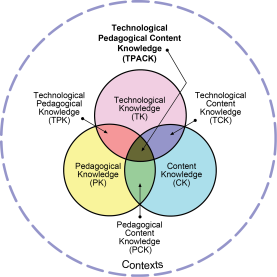Day: July 14, 2015
Lesson Plan: Version 2.0, TPACK Revision

If I could use one word to sum up our learning experience today it would be, TPACK. Our focus centered around the technological, pedagogical, and content knowledge framework. As mentioned previously in a blog post, it is where these three ideas overlap that the conditions are right for dynamic learning to take place. These three knowledge bases cannot be thought of in isolation; rather they must be interwoven to create purposeful lessons (Mishra & Koehler, 2009). It has long been a standard in education that content and pedagogy are integral and now that idea is expanding to include technology. “Rapid changes in technology have added a new kind of knowledge that educators have to integrate with pedagogical and content knowledge” (Mishra & Koehler, 2009). It is through this TPACK lens that I will analyze my lesson plan version 1.0.
CONTENT
When looking at my sixth grade lesson plan about parallel lines cut by a transversal and the angles that are formed, it is evident what the content is. Students at this grade level need to understand angle relationships and the congruencies that are implied by these different relationships. The context of this lesson falls within the geometry unit that I teach to students in my accelerated math class. These children have a strong mathematical knowledge foundation and in order to excel in this lesson they must have prior knowledge about what an angle is, how an angle is formed, what the word congruent means, and that all angles have a degree measure. In this lesson 1.0, I then build on these concepts.
Pedagogy
Referring back to my lesson plan version 1.0 and taking a look at it from a pedagogical standpoint, it is very apparent that I use a lot of direct instruction while also always questioning the students to see if they can come to the correct conclusion first, before I explicitly tell them the correct answer. I begin the lesson with a hook to grab my students’ attention as well as use discussion, real world examples, and individual work to assess my students’ learning. My lesson plan is clear, organized, and through the instructional sequence, it is evident that my two objectives are met.
Technology
In this lesson, I use very little technology but am excited to revamp it at some point in the near future. The hook in my lesson is a youtube video showing a gymnast on the parallel bars. In order to show a video, I will need the computer, projector and SMART Board. Students are also using various colors of pencils (while definitely older technology, we still need them).
Where is the overlap?
The ultimate goal of TPACK is to have these three domains overlap. I do have some interaction in this lesson. The showing of the youtube video is one example where content, pedagogical and technological knowledge interact. Pedagogy tells me I need a way to hook my learners, technology allows me to do that through the use of a video that represents the content by giving a visual representation of parallel lines. Pedagogical and content knowledge overlap when I have the students draw their own example of parallel lines and a transversal in their notebook and show the angle relationships in different colored pencils. Drawing their pictures and owning the material in their notebook, allows for a better transfer of content knowledge. As a teacher, I need to have the knowledge of parallel lines and transversals, as well as understand the common misconceptions that students often have so that I can correct their misunderstandings and they can build upon accurate knowledge. My ability to relate parallel lines to real world contexts (such as railroad tracks, lines on a football field etc.) will also be necessary. These are two other ways pedagogy and content interact.
Is there room for improvement?
When looking at this lesson as a whole, there is definite room for improvement after learning about the TPACK framework. I believe that the content is there, but the pedagogical and technological components could be enhanced. This will only happen if I start experimenting with the TPACK framework and deliberately practice it in my lesson planning (Mishra & Koehler, 2009). I look forward to continuing to revise this lesson and incorporate different frameworks so I can teach this topic most effectively.
References:
Mishra, P. & Koehler. M. J. (2009). Too cool for school? No way! Using the TPACK framework: You can have your hot tools and teach with them, too.
Learning & Leading with Technology, 36(7), 14-18.
TPACK image: Retrieved from http://tpack.org